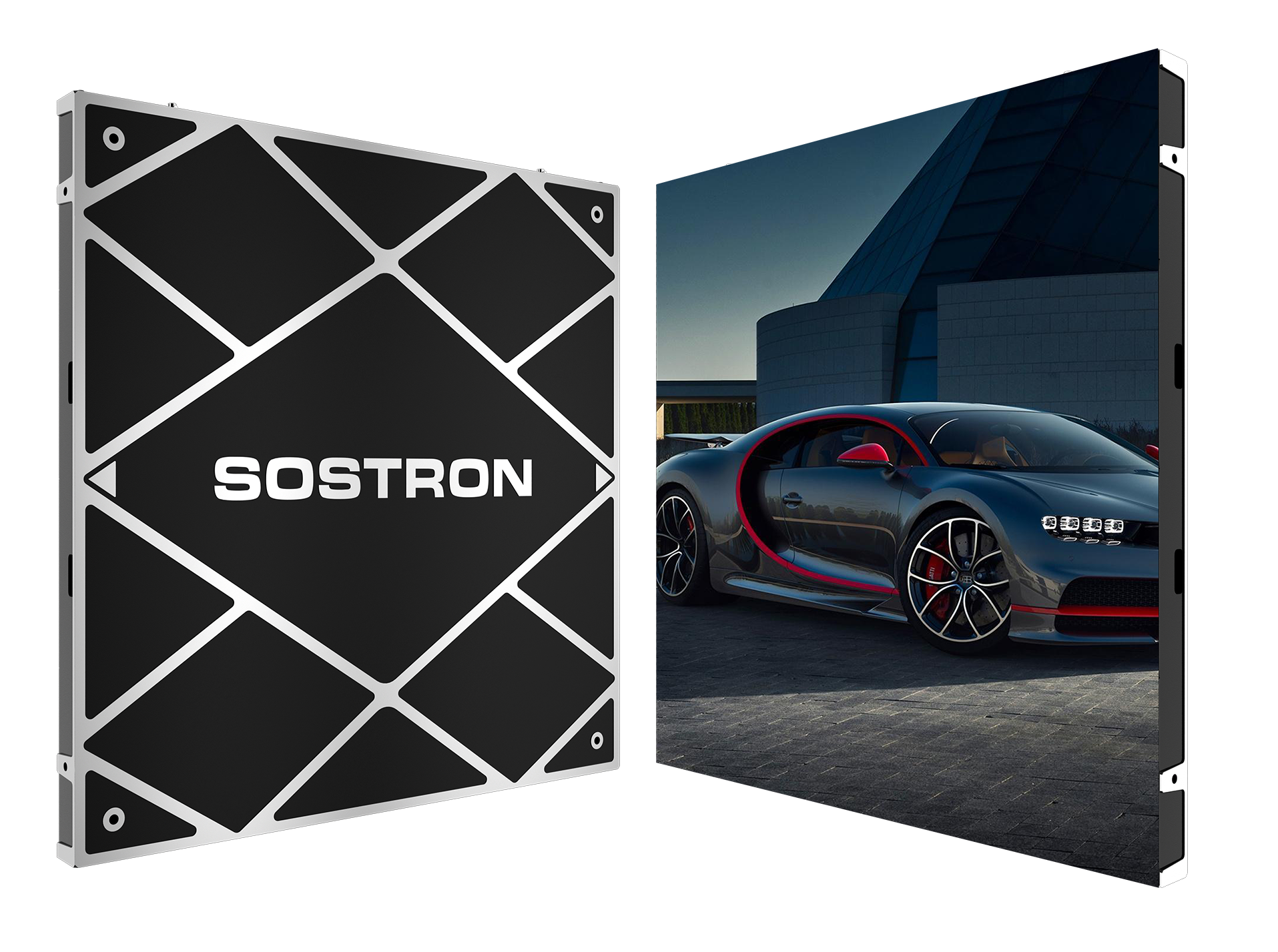Table of Contents
ToggleTable of contents
1. Analysis of pain points of traditional large screen display
2. What is a small-pitch LED display?
3. Definition and classification of small spacing
4. The main difference from traditional LED displays
5. Key points of core technology
6. Main application scenarios
7. Recommended product: SOSTRON Reta 2
8. How to deploy a small-pitch LED display
9, Conclusion
1. The Pain Points of Traditional Large Displays
In today’s information-driven world, LED displays have become an essential part of modern life. From outdoor advertising and commercial showcases to control rooms and corporate meetings, they’re everywhere.
But traditional LED walls have long been plagued by limitations that compromise the viewing experience:
-
Pixelation at close range – like staring at a low-resolution photo.
-
Visible seams between panels – breaking the immersion.
-
Uneven brightness and color shifts – especially noticeable on large-scale visuals.
-
Heat and maintenance issues – long operation cycles cause overheating, and servicing is cumbersome.
These flaws make traditional LED displays unsuitable for high-demand environments where clarity, reliability, and seamless visuals are critical.

2. What Are Fine-Pitch LED Displays?
“Fine-pitch” LED displays refer to screens with extremely small pixel pitch—generally 2.5mm or below. The smaller the pixel pitch (the “P” value), the higher the pixel density, which results in sharper, more detailed images.
3. Types of Fine-Pitch LEDs
Common fine-pitch LED categories include: P2.5, P2.0, P1.86, P1.56, P1.25, and P0.9, with ultra-fine models like P0.7 and P0.6 now entering the market.
-
Example: A P2.5 display means each pixel is 2.5mm apart, while P1.25 shrinks that distance to 1.25mm—delivering far greater detail in the same display size.
Smaller pitch equals better visuals, though costs increase proportionally.
4. Fine-Pitch vs. Traditional LED
| Comparison Point | Traditional LED (P3+) | Fine-Pitch LED (P2.5 or below) |
|---|---|---|
| Pixel Pitch | Larger | Ultra-small (even sub-1mm) |
| Image Quality | Grainy up close | Smooth, detail-rich |
| Panel Seams | Noticeable | Virtually seamless |
| Resolution | Moderate | Extremely high (LCD/DLP level) |
| Main Use Cases | Outdoor ads, stages | Control rooms, meeting spaces, high-end indoor use |
5. Key Technical Features
-
Packaging Technology
-
SMD (Surface-Mount Device): Mature, but less reliable at ultra-small pitches.
-
COB (Chip-on-Board): Direct chip bonding for stronger durability, better heat dissipation—ideal for sub-P1.0 displays.
-

-
Control & Image Processing
-
Advanced controllers ensure high grayscale, fast refresh rates, and accurate color reproduction.
-
Image enhancement improves clarity, detail, and fluidity.
-
-
Thermal Management & Power Efficiency
-
Optimized cooling designs and low-power drivers keep long-term operation stable.
-
-
Display Performance
-
HDR support for richer contrast and color depth.
-
Ultra-high refresh rates (3840Hz+).
-
Smooth grayscale transitions for lifelike visuals.
-
6. Applications of Fine-Pitch LED
Fine-pitch LED displays now dominate premium use cases:

-
Control & Command Centers: Seamless splicing, stable 24/7 operation.
-
Meeting Rooms & Auditoriums: Crisp visuals for efficient collaboration.
-
Broadcasting & Virtual Production: Perfect for high-refresh, high-grayscale demands. Shows like The Mandalorian rely on them.
-
Commercial Exhibits & Brand Showrooms: Immersive, high-end customer experiences.
7. Recommended Product: SOSTRON Reta 2
Modern businesses and educational spaces demand more than just “big screens.” They need clarity, reliability, seamless integration, and smart functionality. The SOSTRON Reta 2 fine-pitch LED is designed to meet these exact needs.

Key Benefits
-
Ultra-thin design (30mm) saves space and looks sleek.
-
Precision die-cast panels ensure flawless, seamless visuals.
-
Wireless connectivity eliminates messy cabling.
-
High refresh rates and rich grayscale for smooth, detailed playback.
-
Competitive long-term cost efficiency thanks to durability and low power use.

Specs at a Glance
-
Brightness: 800–1000 nits
-
Refresh Rate: 7680 Hz
-
Viewing Angle: 160° horizontal & vertical
-
Pixel Pitch Options: P1.25, P1.5, P1.8, P2.5
-
Power Consumption: Avg. 220w/m², Max. 550w/m²
-
Panel Size: 640 × 640 × 30 mm
8. Deployment Best Practices

To maximize ROI, deployment requires careful planning:
Choosing Pixel Pitch by Viewing Distance
-
3m+ → P2.5
-
2–3m → P2.0
-
1.5–2m → P1.5–P1.86
-
<1m → P1.25 or below
Installation Considerations
-
Prioritize front-maintenance designs for easier servicing.
-
Choose mounting methods (wall-mount, hanging, embedded) based on site conditions.
-
Avoid direct sunlight, excessive heat, and humidity.
Control & Content Management
-
Supports multiple inputs (HDMI, DVI, Ethernet, etc.).
-
CMS software allows scheduling, multi-screen synchronization.
-
Optional touch modules enable interactive applications.
Cost vs. ROI
While upfront investment is higher, the payoff includes:
-
Longer lifespan (5–8 years)
-
Lower energy and maintenance costs
-
Enhanced visual impact and brand value
9. Conclusion
Fine-pitch LED displays are redefining the future of visual communication. They solve the long-standing flaws of traditional displays—graininess and panel seams—while opening the door to immersive, lifelike, and intelligent display experiences.
From command centers to Hollywood sets, fine-pitch LEDs are already a staple in cutting-edge industries. And with the rise of 5G, AI, and AR/VR, these displays won’t just show content—they’ll create interactive environments where virtual and real worlds merge.
Fine-pitch LED isn’t just a screen. It’s the bridge to a new era of smart, immersive display technology.

About Dylan Lian
Marketing Strategic Director at Sostron





